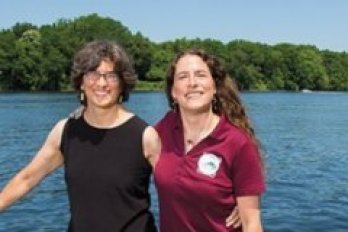Featured in the CNS Newsletter: Issue 14 - February 2017
The RiverSmart Communities program, run by CNS' Center for Agriculture, Food, and the Environment (CAFE), develops strategies for river management that help communities throughout river-rich New England prevent flood devastation. Under the direction of Associate Professor of Geosciences Eve Vogel and UMass Extension Assistant Professor Christine Hatch, researchers work with local residents and governments to address the ever-changing nature of rivers and streams.
“Rivers need room to be rivers,” says Hatch, whose background in hydrology brings science expertise to the program. “If we give rivers enough space, our communities will be resilient to floods, and we end up with a much healthier ecosystem that can reset on its own.” In other words, allowing rivers to move and meander supports a natural process that helps dissipate force; straightening or constraining them can intensify problems upstream and downstream in rough weather.
“They’re dynamic systems,” agrees Vogel, who brings a critical social-science focus to the program but also has a background in ecology and river science. “The notion that a river is a single channel that stays in one place is a fantasy.”
River fluctuation is not necessarily a bad thing. In fact, regular flooding is a component of a healthy environmental system that, among other benefits, deposits nutrients into surrounding soil to create rich farmland. “Flood processes are really essential to the New England that we know and love,” says Vogel. Adds Hatch, “Flooding created this farmland to begin with. Figuring out how to relate these scientific realities to farmers whose fields are at risk, or to landowners seeking to build near the water, is one of our goals.”
Through their original grant from CAFE and the subsequent awarding of federal monies from the USDA National Institute of Food and Agriculture and the U.S. Army Corps of Engineers’ Institute for Water Resources, Hatch and Vogel are compiling best practices for resilient rivers, promoting coordinated watershed management to help farmers before and after floods, and providing policy recommendations to improve federal and state programs that assist affected communities.
Complementing that science and social science, UMass Extension/Outreach is the “equally important third limb,” according to Hatch. “This work,” she says, “isn’t just based on strong academic research. There’s real action at the end of it.” That’s where Vogel’s knowledge of human/environmental dynamics comes in. “I’ve found Eve to be incredibly helpful in casting the information we generate in the right language before we take it out into the community,” continues Hatch. “We’re not just drawing up fact sheets; we’re workshopping with the people affected to make sure our solutions are viable.”
Hatch and Vogel also meet with town residents, planning commissions, farmers, government officials, and other stakeholders to involve constituents in strategic decision-making in an inclusive, participatory way. That may mean bringing the program’s “stream table” to Farm Bureau meetings to visually demonstrate what happens when a river’s natural curves are artificially straightened or when culverts fail. In turn, farmers engage in discussions about which riverside parcels are appropriate for cattle, and where setbacks might be increased to avoid future loss.
“We’ve found that people have done a lot of self-education,” says Vogel. “Communities have a pretty good idea of what is needed.” As a result of these dialogues, local groups and councils have begun to pursue further funding to restore key sections of vulnerable rivers in ways that make them less dangerous to communities downstream. “Those actions speak loudly,” says Hatch. “We’ve helped shape their philosophy of keeping the river whole and keeping river processes in mind.”
The impact goes both ways. “You think you know what’s needed, but the more you talk with people, the more you learn,” says Vogel. “Then it’s a matter of figuring out how to help them get assistance and funds.”
Hatch and Vogel ultimately aim to work on a broader level by bringing changes to state and federal policy and management. Because of New England’s tradition of town rule, working with individual municipalities is essential—and challenging, given that each parcel’s actions affect communities miles downstream, and local officials are often short-term unpaid volunteers. But policy and management changes don’t necessarily require an overhaul of agencies or laws, nor great increases in funding, says Vogel. There are ways to work effectively with existing agencies and policies to better assist communities—for example, by teaching river-science and river-smart best practices to the people likely to be on the ground when future flooding occurs, such as state Department of Transportation and local public works employees. Such efforts both help existing workers do their jobs better and do much to promote long-term community resilience and reduce future costs.
“If you have contingency plans for potential floods and droughts, you’re preparing for climate change,” says Hatch. “This is a perfect example of research with direct, practical applications for people in the community. That’s important to me.”
This story was slightly modified from a story by Ellen Keelan in the 2016 UMass Amherst Report on Researchpublished by Research Next.
Additional news stories on RiverSmart:
Confronting New England's Legacy of Devastating Floods: RiverSmart Recommendations
